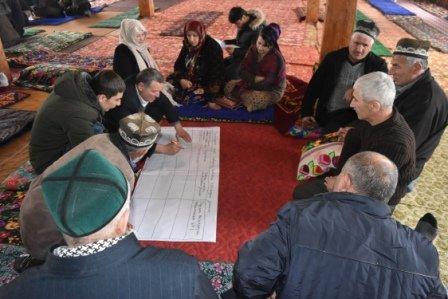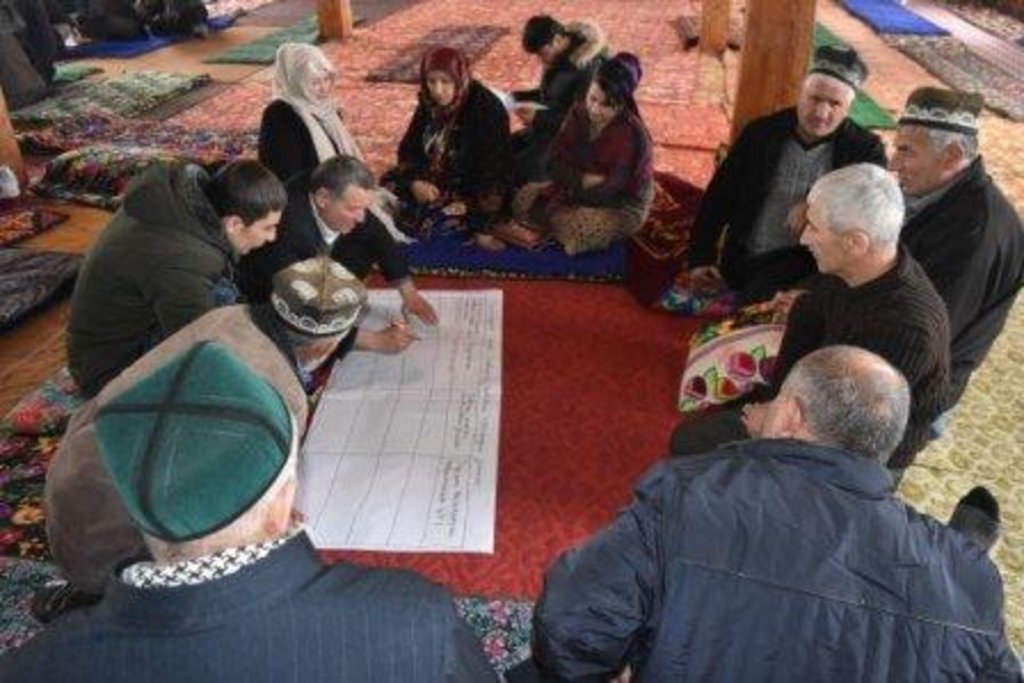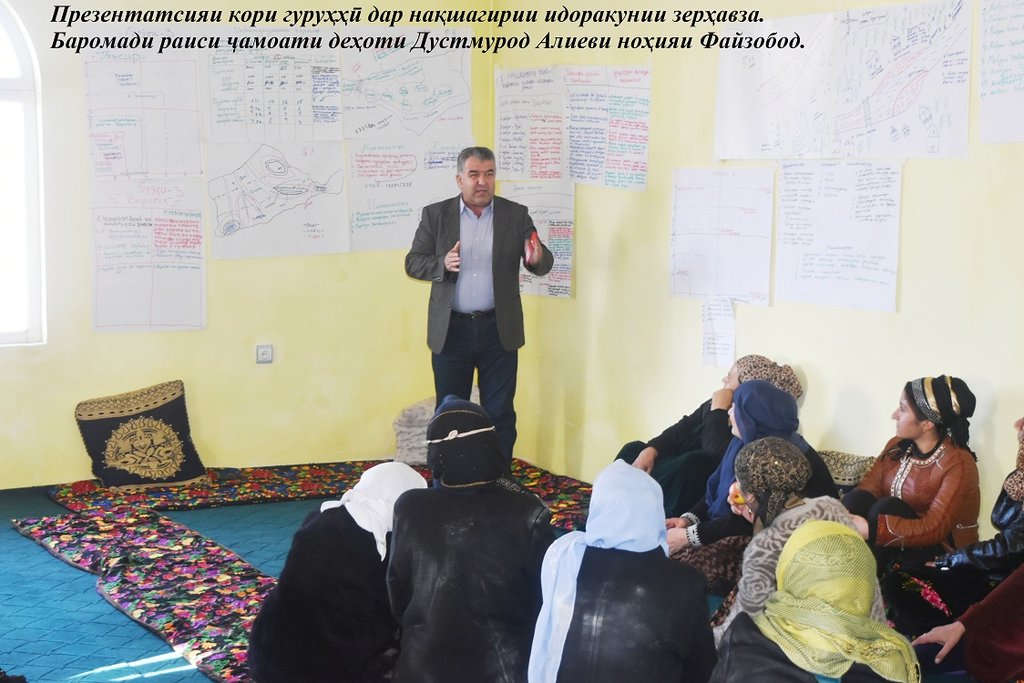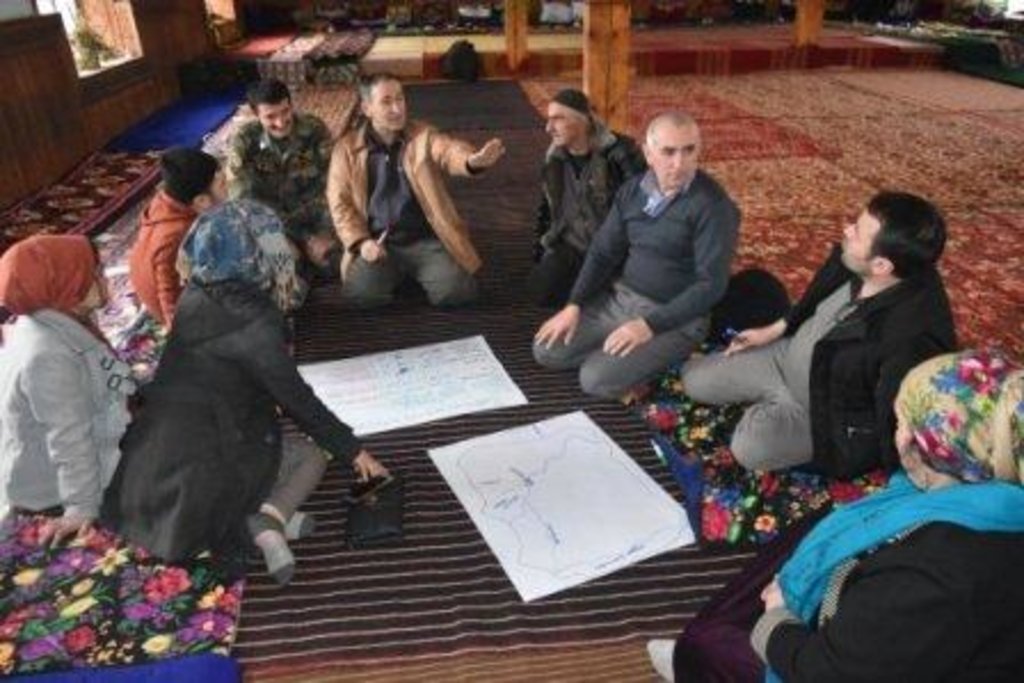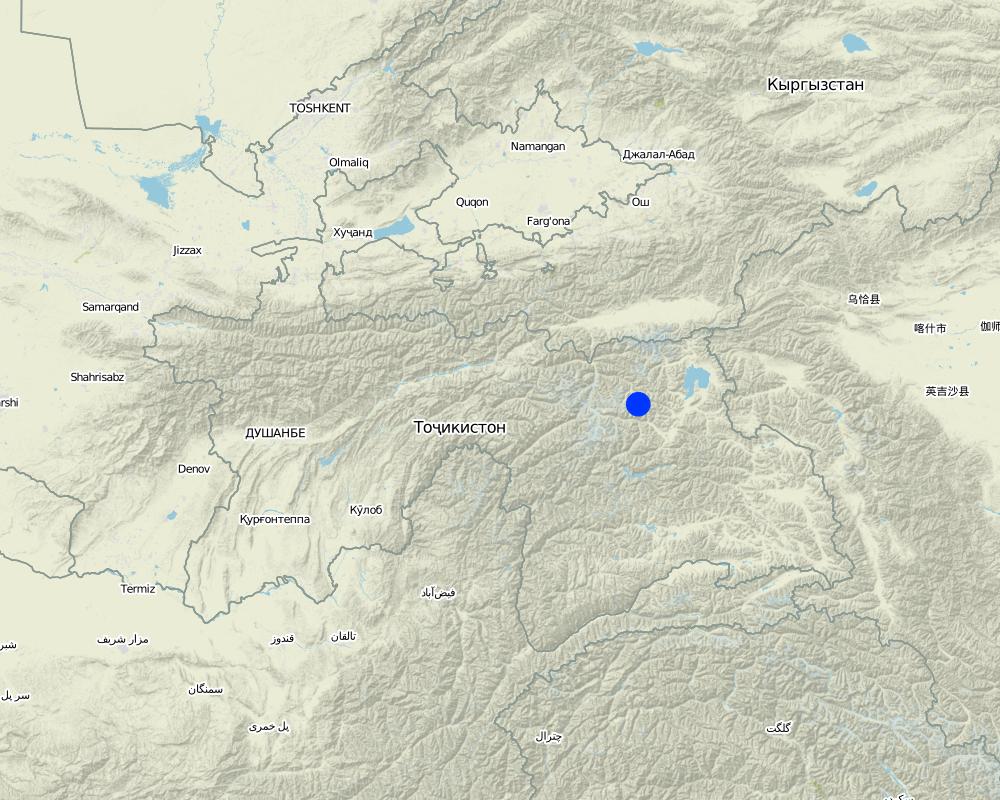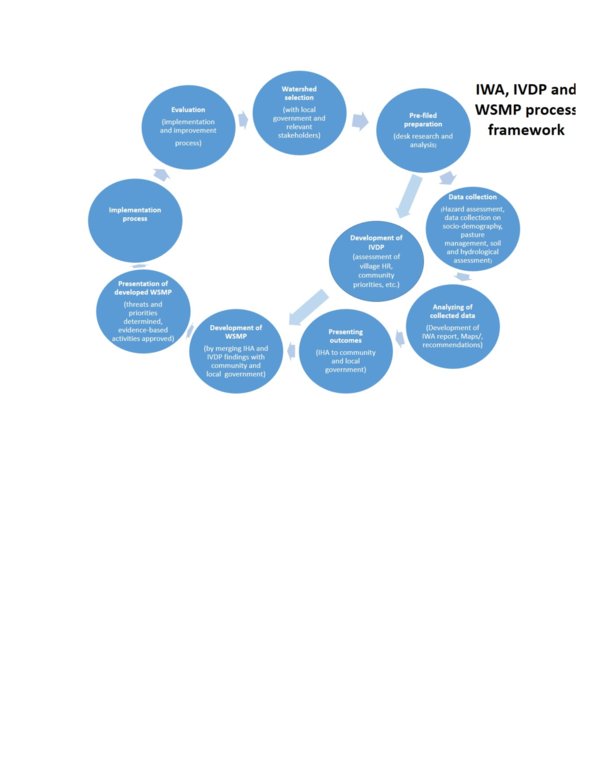Resilient Watershed Management Plan [Tayikistán]
- Creación:
- Actualización:
- Compilador: Askarsho Zevarshoev
- Editor: –
- Revisor: Farrukh Nazarmavloev
Идоракуни Хавза
approaches_3612 - Tayikistán
Visualizar secciones
Expandir todo Colapsar todos1. Información general
1.2 Detalles de contacto de las personas de referencia e instituciones involucradas en la evaluación y la documentación del Enfoque
Nombre del proyecto que facilitó la documentación/ evaluación del Enfoque (si fuera relevante)
Integrated Health and Habitat Improvement in Rasht Valley, TajikistanNombre de la(s) institución(es) que facilitaron la documentación/ evaluación del Enfoque si fuera relevante)
Aga Khan Foundation (AKF) - Suiza1.3 Condiciones referidas al uso de datos documentados mediante WOCAT
¿Cuándo se compilaron los datos (en el campo)?
21/02/2018
El compilador y la/s persona(s) de referencia claves aceptan las condiciones acerca del uso de los datos documentados mediante WOCAT :
Sí
1.4 Referencia/s al/los Cuestionario(s) de Tecnologías MST
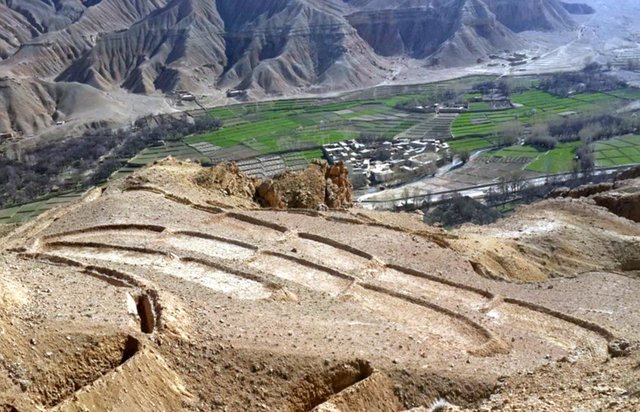
Terracing in Watershed [Afganistán]
Reshaping unproductive land into a series of levelled, gently-sloping platforms creates conditions suitable for cultivation and prevents accelerated erosion.
- Compilador: Aqila Haidery
2. Descripción del Enfoque MST
2.1 Breve descripción del Enfoque
The participatory watershed management plan (WMP) is an interdisciplinary approach at community level to raise awareness on the watershed management concept and improve understanding of the watershed approach in planning and management of natural resource.
2.2 Descripción detallada del Enfoque MST
Descripción detallada del Enfoque MST:
In the participatory WMPs, the main emphasis is placed on identifying critical factors (or so called thresholds) in the sub-watershed and identifying management actions to reduce the potential of negative effects of these factors on the sub-watershed ecosystems and livelihoods. In the process of participatory WMP stakeholders will identify factors that people can control and factors they cannot control. The planning is different for factors that people can control (mitigation of risk factors), for instance sustainability measures of access to safe and clean drinking water, and factors they cannot control (adaptation to risk factors), for instance melting of glaciers and formation of risk-posing glacial lakes.
In WMPs stakeholders collaborate with the technical team to incorporate key findings of the Integrated Habitat Assessment (IHA). To enhance community ownership and participation in the implementation of local development plans, communities and local authorities will be fully involved in the identification, implementation, and handover of the planning process and intervention implementations.
Based on the action plan developed as a result of participatory WMPs, interventions will be implemented to regenerate, protect, or enhance land/resource conditions in the different parts of each sub-watershed in a holistic manner in line with the IWSM approach. Projects at the village level will be identified based on the village management plan and projects operating at the sub-watershed or multi-village level will be informed by WMPs. The resilient NRM activities will be designed to specifically contribute to the improved land use and stabilization of degraded areas in the sub-watershed. During design, protection and synergies will be considered with socio-economic development project.
The WMPs will be prepared for the purpose of enhancing communities’ sustainable development through building capacities and capabilities of local communities to manage and reduce risks from natural hazards, to improve natural resources management, land use planning and pasture management. To conduct the WMP process, a working group will be established at the sub-watershed level, which will include the head of the jamoat(s), representatives from relevant district government departments (Land Management, Geology, Agriculture, Environmental Protection), and representatives from local community based organizations.
The preparation process of the WMPs will be closely coordinated and consulted with the community based organizations as well as local governments with plans conducted at the sub-watershed level. It is tentatively planned that ownership of the plans will fall to either the jamoat government (if a sub-watershed covers only one jamoat) or the district government (in the case of sub-watersheds covering more than one jamoat). However, the ownership model and other aspects of WMP process is still not clear and should be piloted in a different scenario. The WMPs will enable the target sub-watersheds to make comprehensive planning and take into account socio-economic, disaster management, and natural resources management aspects.
As a result of this process, three WMPs were developed at three sub-watershed level in Rasht Valley of Kuksu, Surkhdara and Nushor sub-watersheds. As a result the watershed committee was supported with implementation of interventions, where immediate action was required to prevent further degradation. For example in the Nushori bolo sub-watershed in consultation with government and community mobilization it was agreed to ban grazing in the most degraded upper zone of the pasture, which had also a risk of landslide. In a short period after limiting grazing the pasture areas in the upper zone of watershed started to rehabilitate.
2.3 Fotos del Enfoque
Comentarios generales sobre las fotos:
The head of the local government at the sub-district area which represents the selected watershed is presenting the agreed action plan to all stakeholders. The head of the local government is also a member of the working group on sub-watershed management together with the chairman and land use committee, environmental protection, forestry department.
2.5 País/ región/ lugares donde el Enfoque fue aplicado
País:
Tayikistán
Región/ Estado/ Provincia:
Sub-ordinate regions
Especifique más el lugar :
Rasht Valley, Faizobod District
Map
×2.6 Fechas de inicio y conclusión del Enfoque
Si no se conoce el año preciso, indique la fecha aproximada en la que se inició el Enfoque:
hace menos de 10 años (recientemente)
2.7 Tipo de Enfoque
- proyecto/ basado en un programa
2.8 Propósitos/ objetivos principales del Enfoque
Improvement of natural resource management and prevention of natural hazards as a result of unsustainable use of natural resource.
2.9 Condiciones que facilitan o impiden la implementación de la/s Tecnología/s aplicadas bajo el Enfoque
normas y valores sociales/ culturales/ religiosos
- impiden
the sub-watershed covers several communities, where each community has its own management structure with social and cultural norms. sometimes the social and cultural norms in each communities do not agree with each other because of these different norms and interests.
disponibilidad/ acceso a recursos y servicios financieros
- facilitan
the WMPs, which contains detail aspect of use on different land categories it attracts attention from different funders, including donors and government. in the framework of the project special fund was allocated fro implementation of the designed actions and interventions. This allowed land users and land specialist to implement several planned measures
entorno institucional
- impiden
In the framework of this approach no legal institute exists to own the WMP
colaboración/ coordinación de actores
- facilitan
entails different categories of land use, which involves collaboration among different agencies and land users
marco de trabajo legal (tenencia de tierra, derechos de uso de tierra y agua)
- impiden
there is not official institute, which is dedicated to watershed management. Therefore ownership of the plan is hindering further implementation after the project ends
gobernanza de tierras (toma de decisiones, implementación y aplicación)
- facilitan
The approach brings different local institutes, which are in charge of different natural resources together. This will enable an integrated approach to the natural resource management, as all of them are brought under one action plan.
conocimiento de MST, acceso a apoyo técnico
- facilitan
The approach focuses on different SLM practices and sharing knowledge from different expertice
carga de trabajo, disponibilidad de mano de obra
- impiden
High volume of migration of youth outside the area and high demand for labour force is hindering the process.
3. Participación y roles de las partes interesadas involucradas
3.1 Partes interesadas involucradas en el Enfoque y sus roles
- usuarios locales de tierras/ comunidades locales
community members - farmers, livestock owners, forest owners
As first level of land users they are responsible for overall management of the natural resource and its conservation.
- investigadores
researches - pasture specialist, geobotanics, soil specialist, hydrologist
are involved in technical assessment of the resources and support communities integration of findings into their plan
- profesores/ niños en edad escolar/ estudiantes
teachers on natural sciences and secondary school management
participate in the awareness raising session and support with knowledge sharing with schoolchildren, also use the new knowledge during classes.
- ONG
MSDSP Mountain Societies Development Support Programme
mobilization of stakeholders in development of their participatory plans
- gobierno local
all departments on natural resources management - land, forest, water, pasture
controlling, supervision and mainstreaming the new approach into their working plan
3.2 Involucramiento de los usuarios locales de tierras/ comunidades locales en las distintas fases del Enfoque
| Involucramiento de los usuarios locales de tierras/ comunidades locales | Especifique quién se involucró y describa las actividades | |
|---|---|---|
| iniciación/ motivación | apoyo externo | supported by external consultants to provide feedback on the overall approach |
| planificación | interactivo | participatory approach is applied to develop the plan jointly with the land users |
| implementación | auto-movilización | after the plan is developed and their awareness is raised they take initiative to implement the designed interventions. |
| monitoreo y evaluación | interactivo | the project team jointly with the community members and working group established at the sub-watershed level conducted the monitoring. The working group, which consist of the project team and governmental officials have good knowledge on monitoring skills. |
3.3 Flujograma (si estuviera disponible)
Descripción:
The watershed management circle including the whole circle of the planning process, starting from watershed selection up to evaluation.
Autor:
Zevarshoev Askarsho
3.4 La toma de decisiones en la selección de Tecnología(s) MST
Especifique quién decidió la selección de las Tecnología/ Tecnologías a implementarse:
- todos los actores relevantes, como parte de un enfoque participativo
Explique:
The plan is developed in a participatory way, so everybody is suggesting and participating in the decision making.
Especifique las bases que sustentaron la toma de decisiones:
- la evaluación de conocimiento MST bien documentado (la toma de decisiones se basa en evidencia)
4. Apoyo técnico, fortalecimiento institucional y gestión del conocimiento
4.1 Construcción de capacidades / capacitación
¿Se proporcionó la capacitación a usuarios de tierras/ otras partes interesadas?
Sí
Especifique quién fue capacitado:
- personal de campo/ consejeros
Si fuese relevante, también especifique género, edad, estatus, etnicidad, etc.
women and man, 50-55, local people
Forma de capacitación:
- cursos
Temas avanzados:
Watershed Management
4.2 Servicio de asesoría
¿Los usuarios de tierras tienen acceso a un servicio de asesoría?
No
4.3 Fortalecimiento institucional (desarrollo institucional)
¿Se establecieron o fortalecieron instituciones mediante el Enfoque?
- sí, un poco
Especifique el nivel o los niveles en los que se fortalecieron o establecieron las instituciones:
- local
Describa la institución, roles y responsabilidades, miembros, etc.
local level working group had been established to become owner of the watershed management plan. at the moment the working groups is unofficial and agreed to take of the plan implementation until the official structure is established
Especifique el tipo de apoyo:
- construcción de capacidades/ entrenamiento
Proporcione detalles adicionales:
trainings for community on watershed management, pasture and land management was conducted
4.4 Monitoreo y evaluación
¿El monitoreo y la evaluación forman parte del Enfoque?
No
4.5 Investigación
¿La investigación formó parte del Enfoque?
No
5. Financiamiento y apoyo material externo
5.1 Presupuesto anual para el componente MST del Enfoque
Si no se conoce el presupuesto anual preciso, indique el rango:
- 10,000-100,000
Comentarios (ej. fuentes principales de financiamiento/ donantes principales):
The implementation of the plan is depending on the size of the watershed and the condition to which extent it is degraded and requires rehabilitation measures.
5.2 Apoyo financiero/material proporcionado a los usuarios de tierras
¿Los usuarios de tierras recibieron financiamiento/ apoyo material para implementar la Tecnología/ Tecnologías? :
No
5.3 Subsidios para insumos específicos (incluyendo mano de obra)
- ninguno
Si la mano de obra de usuarios de tierras fue un insumo sustancial, ¿fue:
- voluntario?
5.4 Crédito
¿Se proporcionó crédito bajo el Enfoque para actividades MST?
No
5.5 Otros incentivos o instrumentos
¿Se usaron otros incentivos o instrumentos para promover la implementación de Tecnologías MST?
Sí
Si fuera el caso, especifique :
Certain amount of funding was made available in the first phase to implement part of the action plan under the Watershed Management Plan
6. Análisis de impacto y comentarios de conclusión
6.1 Impactos del Enfoque
¿El Enfoque empoderó a los usuarios locales de tierras, mejoró el involucramiento de las partes interesadas?
- No
- Sí, un poco
- Sí, moderadamente
- Sí, mucho
community members were fully involved in the planning process and participated in decision making with regards to interventions. in addition community members were selected to become member of working groups, which have the opportunity to participate in the overall management of the watershed
after development the plan community were supported with implementation of several intervention specific to each watershed to see the effects
¿El Enfoque mejoró el conocimiento y capacidades de los usuarios para implementar MST?
- No
- Sí, un poco
- Sí, moderadamente
- Sí, mucho
the approach leads to the development of action plan with the expertise from SLM experts where different technologies are applied as a result of implementation of the actions related to watershed improvement
¿El Enfoque mejoró el conocimiento y capacidades de otras partes interesadas?
- No
- Sí, un poco
- Sí, moderadamente
- Sí, mucho
it involves also capacity building of the stakeholders and improves their awareness on the watershed management approach
¿El Enfoque mejoró la equidad de género y empoderó a las mujeres y niñas?
- No
- Sí, un poco
- Sí, moderadamente
- Sí, mucho
It brings all stakeholders together to make decision with agreement with each other. women and girls also participated actively at the community planning process and were involved in the decision making
¿El Enfoque alentó a jóvenes/ la siguiente generación de usuarios de tierras a involucrarse con MST?
- No
- Sí, un poco
- Sí, moderadamente
- Sí, mucho
in the implementation process of intervention mainly were involved youth jointly with technical project team, NRM specialist and bio-soil engineering and had a chance to learn new technologies and skills
in the implementation process jointly with project experts, including NRM specialist and bio-soil engineer different SLM technologies were implemented at the sub-watershed level
¿El Enfoque mejoró la capacidad de los usuarios de tierras a adaptarse a los cambios climáticos/ extemos y mitigar desastres relacionados al clima?
- No
- Sí, un poco
- Sí, moderadamente
- Sí, mucho
beside overgrazing, heavy precipitation in the last years have exacerbate the pasture degradation. through introducing new measures this contribute to minimize the effect of the heave precipitation, which is the cause of climate change.
¿El Enfoque llevó a oportunidades de empleo, ingresos?
- No
- Sí, un poco
- Sí, moderadamente
- Sí, mucho
it only enable stakeholders and land users with improvement of land use and disaster protection
6.2 Motivación principal del usuario de la tierra para implementar MST
- reducción de la degradación de la tierra
In the long run the plan improves the land degradation by applying different methods and environmental protection measures.
- reducción del riesgo de desastres naturales
In most of the cases the forms of land use which lead to disasters were banned in order to rehabilitate the area. Different technologies were applied to reduce disaster risks.
- reglas y reglamentos (multas)/ aplicación
The approach focuses on improving the regulation on natural resource use in the watershed context as well as setting up common rules among different stakeholders to protect land.
6.3 Sostenibilidad de las actividades del Enfoque
¿Pueden los usuarios de tierras sostener lo que se implementó mediante el Enfoque (sin apoyo externo)?
- incierto
Si respondió no o incierto, especifique y comente:
There is no legally registered entity who owns the plan as a result of the approach, otherwise the working group is consisting of governmental representatives and community members to manage the plan
6.4 Fortalezas/ ventajas del Enfoque
| Fuerzas/ ventajas/ oportunidades desde la perspectiva del usuario de la tierra |
|---|
| developed in participatory manner, involved in decision making |
| Fuerzas/ ventajas/ oportunidades desde la perspectiva del compilador o de otra persona de referencia clave |
|---|
| represented by all parties involved in managing and using natural resource in the context of watershed |
| if legalized and owned by special entity can highly contribute to the improvement of natural resource conditions |
| could be replicated to other part/watershed as capacity on development of the approach is already built in the area |
6.5 Debilidades/ desventajas del Enfoque y formas de sobreponerse a ellos
| Debilidades/ desventajas/ riesgos desde la perspectiva del compilador o de otra persona de referencia clave | ¿Cómo sobreponerse a ellas? |
|---|---|
| absence of ownership interest over the plan developed as a result to the approach |
7. Referencias y vínculos
7.1 Métodos/ fuentes de información
- entrevistas con usuarios de tierras
13
- entrevistas con especialistas/ expertos en MST
4
- compilación de informes y otra documentación existente
1
7.2 Referencias a publicaciones disponibles
Título, autor, año, ISBN:
Zevarshoev Askarsho
¿Dónde se halla disponible? ¿Costo?
free, available upon request
7.3 Vínculos a la información relevante disponible en línea
Título/ descripción:
Zevarshoev Askarsho/Resilient Watershed Management Methodology
URL:
available upon request
Vínculos y módulos
Expandir todo Colapsar todosVínculos

Terracing in Watershed [Afganistán]
Reshaping unproductive land into a series of levelled, gently-sloping platforms creates conditions suitable for cultivation and prevents accelerated erosion.
- Compilador: Aqila Haidery
Módulos
No se hallaron módulos


